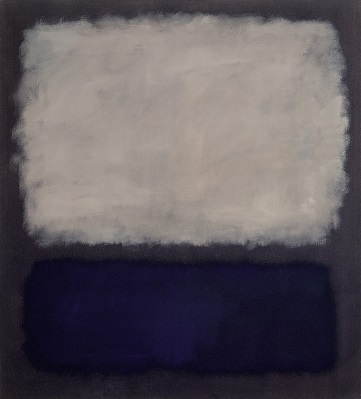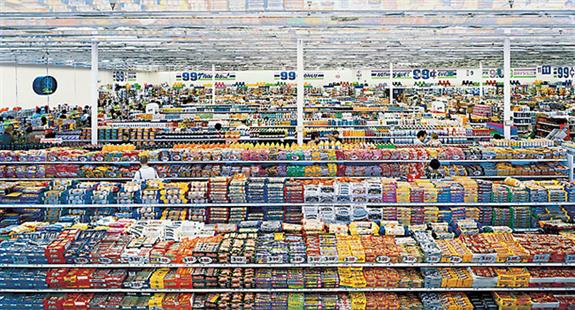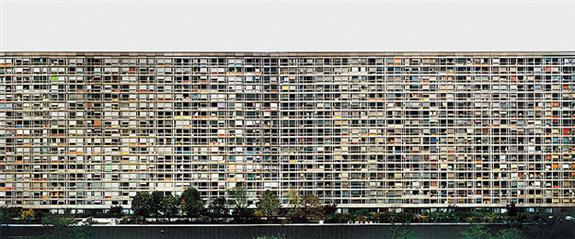
New York City, 1963. Lee Friedlander (Fig. 2)
What I have been trying to argue is not intended as a criticism of Friedlander’s work nor as a challenge to his status within the world of (art) photography. If anything it is a challenge to the ideas that held such sway through the fifties sixties and seventies that each art form has an essential nature, and that quality is dependent on an en engagement with those properties unique to the art form.
Photography and the Aesthetics of Abstract Painting
By Robin Marriner, Senior Lecturer Critical Studies, Bath School of Art & Design, Bath Spa University, UK
It is not difficult to imagine if one was unfamiliar with photographic culture and had encountered individual random examples of Lee Friedlander’s work becoming perplexed on being told that Friedlander was one of the most important photographers of the past fifty or so years. On a first encounter many of his images seem to have a level of casualness, perhaps even carelessness that one would not recognize as differentiating them from much other vernacular photography let alone destine them to the consecration and acclaim they have received on numerous occasions from the Museum of Modern Art. (e.g MOMA 1967, 1978, 2005, and literature doesn’t enlighten one as to the why). (Fig 2, 3, 4)

New York City, 1963. Lee Friedlander (Fig. 2)

Hillcrest, New York, 1970. Lee Friedlander (Fig. 4)
In her seminal paper on Friedlander, “Guarded Strategies”, Martha Rosler picks up on this ostensible casualness and proposes two sets of oppositions in terms of which Friedlander’s work can be illuminatingly positioned: formal v transparent, transcendental v literal. She argues that for all their prima facie ‘casualness’/‘carelessness’ and the ‘ordinariness’ of what the individual images present which seems to align them with the transparent and literal, with the vernacular and documentary, across the body of the work there are recurring features which draw attention to it as imaged and as images, i.e. subvert its transparency and tilt its categorization towards the formal and transcendent and art. As she comments “Most of the issues of painterly ‘’design” within a rectangular format turn up in his photos”. Given this insight, surprisingly she then goes on to name and herself explore only two of these incidences: “echoes of analytic Cubism’ and “the look of collage- the (apparent) joining of disparate elements and image fragments “.

New Orleans, Louisiana, 1969. Lee Friedlander

Los Angeles, California, 1965. Lee Friedlander

Nashville, Tennessee, 1971. Lee Friedlander (Fig. 3)
This paper pursues what I understand as mooted by Rosler but unexplored. I want to suggest that at a time when judgments about quality of the visual were premised on notions of the ‘essence’ and ‘specificity’ of media, the time of Late Modernism as forcefully articulated by Clement Greenberg and Michael Fried (Greenberg 61 ,82 , Fried 66 ,etc), the recurrent strategies through which Lee Friedlander’s works can be read to assert their facticity as photographs, their presence as two-dimensional surfaces simultaneously with their presence as illusionistic images, i.e. their place as belonging within the Museum of Modern Art, are aesthetic strategies which had already had a currency as signifiers of surface and flatness in American Abstract painting of the 1950s and 1960s.

Cathedra, 1951. Newman Barnett

George Washington Bridge, New Jersey, 1973. Lee Friedlander

Santa Fe, New Mexico, 1969. Lee Friedlander
One of the recurring features across Friedlander’s work is a particular use of the frame in which foreground verticals traverse the images and extend beyond its top and bottom limits. In relation to one model of imaging, that which aspires to transparency and to pictorial composition which seeks clarity of subject matter as a primary quality of good photography these photographs seem to embody a shortfall. The various telegraph poles, lamp posts, street signs, steel hausers etc, seem to get between the viewer/us and the scene beyond which one assumes is the focus of attention/interest, – and perhaps account for the ‘coolness’ or detachment that is often attributed to Friedlander’s images – ; read on this model the street furniture act as a ‘barrier’ to one’s sight, literally set us at a distance from the ‘scene’. From a different perspective, that which is concerned less with transparency but with what in the fifties, sixties and seventies might well have been expressed as concerned with ‘photography as such’ the vertical obtrusions take on a different signification.
The vertical stripes within Barnett Newman’s paintings from the nineteen fifties are read within formalist criticism as significant because of what they do to our experience and concept of a painting. Greenberg (et al) have argued that the vertical stripes up against the picture plain positioned against an ambiguous ‘optical’ space, re-iterate the edge of the support (canvas), and in so doing give us an experience of the edges as part of the painting (as if further verticals (stripes) on the surface) rather than containers of it. The effect of the edge becoming part of the painting is to underscore our experience of the painting as surface, as flat (even if there is an optical space with it.) and by so doing declare its facticity, the truth of what it is. Within this frame, if we are prepared to accept as many did, Greenberg’s claims as to the effects of the stripes, the verticals within Friedlander’s photographs appear less as obtrusions to the scenes depicted than signifiers of the photograph itself, a means to declare its flatness and facticity.

New York City, 1963. Lee Friedlander

New York City, 1975. Lee Friedlander

Number One, 1949. Jackson Pollock
Another frequently recurring feature in Friedlander’s photographs is the manner in which he uses frontality and the frame to generate a conspicuous degree of patternation across the image – for example the use of mesh fencing or foliage in the foreground of the image. Again here as with the verticals referenced above, on a model of transparency, the fences and foliage appear as obstructions to a clear view of the scene, but read within the dominant critical frame of painting at the same moment, the same features take on a signification that locates the photographs, perhaps even confirms the photographs as art.
Amongst the many claims that are made of Pollock in his ‘drip-paintings’, for example, that he undermined the distinction between drawing and painting, that he frees painting from its concern with illusionistic representational space, etc, the one that is perhaps of most weight and significance is that he has through these paintings changed the nature of pictorial composition of western art. Through working the paintings from all sides (on the floor) and ‘cropping’ or stretching the canvases after Pollock, it is claimed, has generated images which have an equal intensity of pictorial incident across their whole surface: what has been designated as ‘overall-composition”. Instead of pictorial composition involving the reconciliation of shapes within the space bounded by the edges and to that degree subordinated to them as something which contained but was not part of the painting, – for example way that the intensity of incident in the centre of Cubism’s shallow-box like picture plane has to be thinned out to reconcile that picture plane to the edges – Pollock’s drip paintings in their evenness of pictorial incident look as if they could go on laterally and vertically indefinitely, their edges being an arbitrary cut on their surface rather than enclosures for the work. The overall composition of Pollock is heralded (as Lieder says) as ‘the exquisite triumph of the two dimensional manner’ in painting, here it is enough to note that an overall distribution of pictorial incident underscores two dimensionality, and such draws attention to the surface as surface, as stuff and opaque not transparent.
It is not that there cannot be found within photography itself precedents for the ‘look’ of that to which I am pointing, for example what can be read as the underscoring of surfaces in Frank (Fig 23 Barbershop) and (Fig 24 Venice), the framing and frontality in Evans, (Store front, Fig 25 and Gas Station, Fig 26 F) and Frank (Trolley Fig 27) but rather that what gives those features the signification that they are now read to have, and Friedlander’s work too is the meaning given to them in the paintings: i.e. signifiers of facticity.

Barbershop through screen door. McClellanville, South Carolina, 1955-56. Robert Frank

Backyard. Venice, California, 1955-56. Robert Frank

Painting, 1951. Clyfford Still
What I am suggesting is that through photographic means Friedlander has managed to address issues that were (and to a degree still are) central to art culture.
According to Greenberg, despite the jagged edged forms and uneven ‘autumnal’ palette that set up the degrees of depth and space, what redeems a typical Clyfford Still painting is the way in which they avoid enclosed or bounded figures by running shapes off the edges. The running of figures off or over the edge, something which 19C painters like Degas learnt from the framing/cropping of photography is here being posited as another strategy through which pictorial depth can be reconciled to the actuality of painting as flat. The cropping of the faces and heads in the New York (Fig 2) and Nashville (Fig 3) Friedlander images shown very early in this presentation might be read in this way, as I think can the images in which rather than cutting things off, phenomena are allowed to intrude from beyond the edge into the picture, e.g. branches, foliage and traffic lights and signs, with the same perceptual effects i.e. undercutting the illusion of depth within the image as one’s eye is led to and across its edge. (Fig 30, Fig 31, Fig 32, Friedlander)

Brink, 1959. Adolf Gottlieb (Fig. 32)

Blue and Gray, 1962. Mark Rothko (Fig. 37)

Akron, Ohio, 1980. Lee Friedlander (Fig. 35)

Sceaux, France, 1973. Lee Friedlander (Fig. 36)
In his 1955-58 essay “American-type painting” Greenberg has this to say of Adolf Gottlieb: (Greenberg 1961, 216) “ he has made himself one of the surest craftsmen in contemporary painting: one who can, for instance, place a flat and irregular silhouette, that most difficult of all shapes to adjust in isolation to the rectangle, with a force and rightness no other living painter seems capable of.” Perhaps one might say of Friedlander as a photographer, that he too, not without a lightness of touch/sense of humour has achieved a similar feat for not dissimilar ends. ((Fig 35, Fig 36 Friedlander).
Not just Gottlieb but Rothko (Fig 37) places elements of his paintings perceptually up against the picture plane and whilst using more ‘regular shapes’ he too gives those elements ‘soft’ or fuzzy edges. The combined effect of the placement in the foreground and the ‘softness’ of its edges is both to underscore the work’s surface and also render the space/depth within the work ambiguous, a description that seems to be equally apposite to Friedlander’s photographic equivalent to the painterly strategies.
What I have been trying to argue is not intended as a criticism of Friedlander’s work nor as a challenge to his status within the world of (art) photography. If anything it is a challenge to the ideas that held such sway through the fifties sixties and seventies that each art form has an essential nature, and that quality is dependent on an en engagement with those properties unique to the art form. What I have tried to show rather perhaps suggests something of why he is held in such high regard in a way that the writings issuing from MOMA during that period for me fail to do with the under-developed concept of ‘camera vision’ (New Documents. 1967) or such vagueness as “What unites the photographers included in the exhibition is their common “pursuit of beauty: that formal integrity that pays homage to the dream of meaningful life.” Both approaches are, in fact, part of a single if complex tradition.”” (Mirrors and Windows 1978). What I am suggesting is that through photographic means Friedlander has managed to address issues that were (and to a degree still are) central to art culture. At least armed with art culture knowledge the works can be so read. Whatever we may think about the quality of the work as representations of the social scene, it seems to me that it is the significations it yields in relation to the knowledge and aesthetic concerns of art culture that its standing within MOMA is to be sought. It therefore perhaps should come as no surprise that one can see the same preoccupations, albeit writ (literally) large – the frontality, the framing, the acknowledgement of flatness through the re-iteration of the edge, both vertical and horizontal constituting a grid, or an equal distribution of pictorial incident across the whole surface, in conjunction with a massive scaling up of image to the size of many post World War II paintings- in the works of the photographer who more than any other thus far has secured the status of artist, namely Andreas Gursky.

99 Cent Store, 1999. Andreas Gursky (Fig. 38)

Montparnasse, Paris, 1993. Andreas Gursky (Fig. 39)
Notes
Rosler, M. 1975 “Guarder Strategies”, Artforum. April: 46-54
Greenberg, C. [1955, 1958] 1961. “ “American Type” Paining ” in Greenberg, C. Art and Culture. Boston: Beacon Press.
Greenberg, C. [1965] 1982. “Modernist Painting” in Frascina, F & Harrison, C (eds). Modern Art and Modernism: a critical anthology. London: Harper & Row.
“The essence of Modernism lies, as I see it, in the use of the characteristic methods of a discipline to criticise the discipline itself- not in order to subvert it but to entrench it more firmly in its area of competence of each art, it turned out had to effect this demonstration on its own account. What had to be exhibited and made explicit was that which was unique and irreducible not only in art in general, but also in each particular art…
‘It quickly emerged that the unique and proper area of competence of each art coincided with all that was unique to the nature of its medium. The task of self-criticism became to eliminate from the effects of each art any and every effect that might conceivably be borrowed from or by the medium of any other art. Thereby each art would be rendered ‘pure’, and in its ‘purity’ find the guarantee of its standards of quality as well as of its independence. ‘Purity’ meant self-definition, and the enterprise of self-criticism in the arts became one of self-definition with a vengeance. (p5/6)
Fried, M 1966. “Shape as Form: Frank Stella’s New Paintings, Artforum, (Nov): 17-32
Fried 1966 Footnote 8: ‘And in fact – despite the proliferation of work that is neither painting nor sculpture, and despite the pervasiveness of the facile notion (hawked recently by Susan Sontag) that the arts in our time are at last heading towards synthesis – what modernism has come increasingly to mean is that, more than ever, value or quality can be predicated of work that lies only within not between the individual arts.
Greenberg , C 1961 , see note ii.
Leider P 1970, ‘Literalism and Abstraction, Frank Stella’s Retrospective at the Modern’, Artforum, (April): 44-51.
(All rights reserved. Text @ Robin Marriner, Images @ Lee Friedlander)